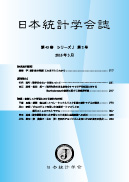Volume 45, Issue 2
Displaying 1-7 of 7 articles from this issue
- |<
- <
- 1
- >
- >|
Presidential Address
-
2016Volume 45Issue 2 Pages 217-230
Published: April 07, 2016
Released on J-STAGE: January 27, 2017
Download PDF (845K)
Articles
-
2016Volume 45Issue 2 Pages 231-245
Published: April 07, 2016
Released on J-STAGE: January 27, 2017
Download PDF (685K) -
2016Volume 45Issue 2 Pages 247-271
Published: April 07, 2016
Released on J-STAGE: January 27, 2017
Download PDF (722K)
Special Section: Statistical Methods in Financial Risk Management
-
2016Volume 45Issue 2 Pages 273-305
Published: April 07, 2016
Released on J-STAGE: January 27, 2017
Download PDF (4691K) -
2016Volume 45Issue 2 Pages 307-328
Published: April 07, 2016
Released on J-STAGE: January 27, 2017
Download PDF (1028K) -
2016Volume 45Issue 2 Pages 329-352
Published: April 07, 2016
Released on J-STAGE: January 27, 2017
Download PDF (1090K) -
2016Volume 45Issue 2 Pages 353-375
Published: April 07, 2016
Released on J-STAGE: January 27, 2017
Download PDF (1345K)
- |<
- <
- 1
- >
- >|
